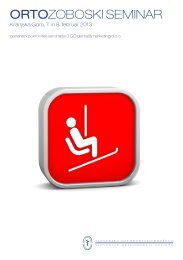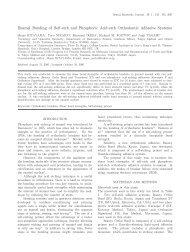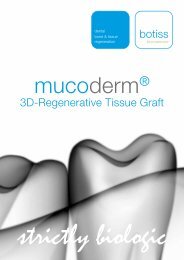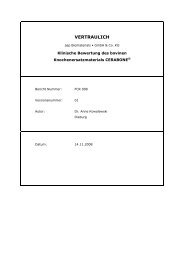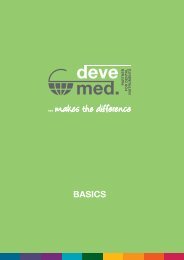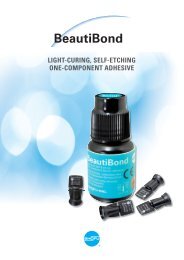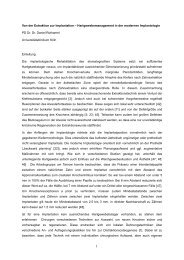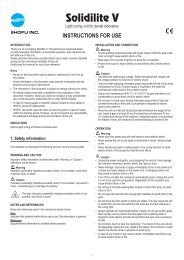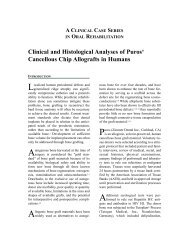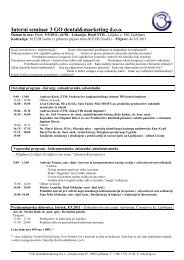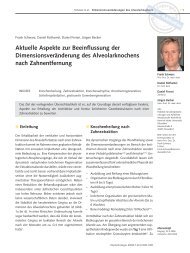Duraplasty: Our Current Experience - 3 go / dental&marketing
Duraplasty: Our Current Experience - 3 go / dental&marketing
Duraplasty: Our Current Experience - 3 go / dental&marketing
You also want an ePaper? Increase the reach of your titles
YUMPU automatically turns print PDFs into web optimized ePapers that Google loves.
Technology<br />
<strong>Duraplasty</strong>: <strong>Our</strong><br />
<strong>Current</strong> <strong>Experience</strong><br />
Emanuela Caroli,* Giovanni Rocchi,* Maurizio Salvati,† and Roberto Delfini*<br />
*Department of Neurological Sciences, †Department of Neurosurgery, INM Neuromed<br />
IRCCS, University of Rome “La Sapienza,” Rome, Italy<br />
Caroli E, Rocchi G, Salvati M, Delfini R. <strong>Duraplasty</strong>: our current<br />
experience. Surg Neurol 2004;61:55–9.<br />
BACKGROUND<br />
A large variety of biologic and artificial materials have<br />
been suggested as dural substitutes. However, no ideal<br />
material for dural repair in neurosurgical procedures has<br />
been identified. The authors report their experience with<br />
Tutoplast processed dura and pericardium.<br />
METHODS<br />
This study is designed to evaluate Tutoplast dura and<br />
pericardium. The study population was composed of 250<br />
consecutive patients who underwent cerebral duraplasty<br />
with these homolo<strong>go</strong>us materials between 1996 and 1998.<br />
The average follow-up was 5.4 years.<br />
RESULTS<br />
We have observed only four complications with uncertain<br />
relationship with the dural implant. These resulted in<br />
complete recovery.<br />
CONCLUSIONS<br />
We support the efficacy and safety of this natural dural<br />
substitute treated with Tutoplast method. © 2004<br />
Elsevier Inc. All rights reserved.<br />
KEY WORDS<br />
Dura mater, graft sterilization, dural substitute, dural implant,<br />
complications.<br />
After cerebral or spinal operative procedures,<br />
it is imperative to provide a complete and<br />
watertight dural closure to minimize the risks of<br />
cerebrospinal fluid fistulas, infections, brain herniation,<br />
cortical scarring, and adhesions [18,46,47].<br />
<strong>Duraplasty</strong> is required in several instances<br />
[3,4,14,25,29,46,30]: 1) to substitute a loss of native<br />
dural tissue (i.e., in neoplastic or traumatic destruction);<br />
2) to repair dural fistulas; 3) to enlarge the<br />
dural compartment (i.e., in Arnold-Chiari malformation<br />
or inoperable intramedullary tumors); 4) when<br />
the closure is difficult and not sufficiently watertight<br />
This paper has been written without any financial arrangements with<br />
the dural substitute manufacturer.<br />
Address reprint requests to: Dr. Emanuela Caroli, Via Meropia 85, 00147<br />
Rome, Italy.<br />
Received June 6, 2002; accepted June 9, 2003.<br />
because dura mater edges have shrunken and they<br />
cannot be sutured directly; 5) in dura graft surgery<br />
(i.e., myelomenin<strong>go</strong>cele).<br />
Despite 100 years of experimentation and investigation<br />
of a wide range of materials, the searches<br />
for the ideal substitute still continues.<br />
We report the clinical results in a consecutive<br />
series of 250 patients who underwent cerebral dural<br />
implant with Tutoplast processed dura and<br />
pericardium.<br />
Materials and Methods<br />
This study is designed to evaluate the outcome of a<br />
consecutive series of 250 patients who underwent<br />
cerebral duraplasty between 1996 and 1998 at our<br />
institution with the following substitutive materials:<br />
Tutoplast Pericardium (149 patients—58.8% of the<br />
cases), and Tutoplast Dura (101 patients—41.2% of<br />
the cases).<br />
<strong>Our</strong> study included 106 males and 144 females.<br />
Age ranged between �0 and 83 years (mean age was<br />
50 years). Grafting was performed on primary or<br />
secondary tumors (44.54% of the cases), mainly<br />
meningiomas (63%), cerebro-spinal fluid fistulas<br />
(25.61% of the cases: 42 posttraumatic, 12 spontaneous,<br />
and 8 iatrogenic), craniocerebral trauma<br />
(18.4%), Arnold-Chiari malformation (7.74 10.33%),<br />
and aneurysms (3.71%).<br />
Follow-up ranged from 4 to 6 years (mean 5.4).<br />
Seven patients underwent an early reoperation<br />
(less than 9 months after surgery), 2 for complications<br />
likely related to the dural graft, and the remaining<br />
5 for other reasons. Nine patients underwent<br />
a reoperation after a long interval for<br />
recurrent tumor. Eleven patients were excluded<br />
from this study because 8 (3.2%) died from the<br />
progression of the primary disease in a period from<br />
6 months to 2.8 years after surgical treatment, and<br />
3 (1.2%) died of complications in the postoperative<br />
© 2004 Elsevier Inc. All rights reserved. 0090-3019/04/$–see front matter<br />
360 Park Avenue South, New York, NY 10010–1710 doi:10.1016/S0090-3019(03)00524-X
56 Surg Neurol Caroli et al<br />
2004;61:55–9<br />
period. Four of the 239 remaining patients presented<br />
complications suspected to be related to the<br />
dural implant.<br />
CASE 1<br />
A 28-year-old man was operated on for arachnoid<br />
cyst in posterior cranial fossa, and a Tutoplast pericardium<br />
implantation was performed. Immediately<br />
after operation, the patient presented fever and<br />
meningismus. A computed tomography (CT) scan<br />
showed a cerebral spinal fluid (CSF) collection in<br />
the operative field. Multiple CSF cultures failed to<br />
reveal bacterial growth. The symptoms were<br />
abated by corticosteroid administration.<br />
CASE 2<br />
A 47-year-old woman was operated on for a melanoma<br />
of the cavernous sinus, and a Tutoplast pericardium<br />
patch implantation was performed. On the<br />
50 th postoperative day she presented rhinorrhea,<br />
headache, neck stiffness, and fever. Cultures of the<br />
CSF were positive for Enterococcus faecalis. The patient<br />
was treated with antibiotic therapy, and after<br />
1 week the clinical picture regressed and 1 month<br />
later the cultures of the CSF were negative. In this<br />
case a second operation was not performed because<br />
rhinorrhea ceased spontaneously.<br />
CASE 3<br />
A 42-year-old man operated on for cerebellar hemangioblastoma<br />
underwent a Tutoplast Dura patch<br />
implantation. Two weeks later, the patient presented<br />
fever and swelling of the surgical wound.<br />
Cultures of the purulent material taken from the<br />
swelling and CSF cultures revealed Staphilococcus<br />
aureus. The patient was reoperated; during the second<br />
operation we found subcutaneous and submuscular<br />
purulent material. Tutoplast Dura was reabsorbed<br />
and cerebellar surface was unaltered. The<br />
operative field was meticulously cleaned with hydrogen<br />
peroxide and local antibiotics. A second<br />
Tutoplast Dura patch was implanted. Daily wound<br />
medications were administered. The postoperative<br />
course was uneventful, and the patient was discharged<br />
on sixth postoperative day.<br />
CASE 4<br />
A 70-year-old man treated for a ponto-cerebellar<br />
angle neurinoma underwent a Tutoplast pericardium<br />
patch implantation. One month later, he complained<br />
of headache, vomiting, SC pain, and swelling<br />
at surgical wound. Cultures of purulent material<br />
taken from swelling revealed Staphilococcus<br />
epidermidis.<br />
The patient was reoperated, and during the second<br />
operation we found a corpuscolar collection<br />
under the cutaneous and muscular planes. Dural<br />
implantation was reabsorbed, and the cerebellar<br />
surface presented a small cavity coated with necrotic<br />
tissue. The operative field was meticulously<br />
cleaned with hydrogen peroxide and local antibiotics.<br />
A new Tutoplast pericardium patch was implanted.<br />
Daily wound medications were administered.<br />
The postoperative course was uneventful,<br />
and the patient was discharged on 7 th postoperative<br />
day.<br />
Tutoplast dura and Tutoplast pericardium are<br />
homolo<strong>go</strong>us materials treated with dehydration by<br />
solvent and sterilization by � irradiation. These materials<br />
are immersed in a hydrogen peroxide and<br />
acetone solution to minimize the antigenic potential<br />
and the infection risk. The preservation temperature<br />
is 15–30°C. For use, it is recommended to rehydrate<br />
Tutoplast dura and Tutoplast pericardium<br />
in sterile physiologic saline or Ringer’s solution.<br />
The rehydration makes these materials even softer<br />
and improves their handling properties at surgery.<br />
These materials are a network of collagen fibers<br />
that act as a scaffold for the formation of vascularized,<br />
vital, connective tissue.<br />
Discussion<br />
Since 1890 when Beach suggested use of <strong>go</strong>ld foil to<br />
prevent menin<strong>go</strong>cerebral adhesions [5], many substances<br />
have been tried experimentally and used<br />
clinically as dural substitutes. However, the ideal<br />
solution still remains to be found. Watertight dural<br />
closure is necessary to prevent postoperative cerebrospinal<br />
fluid fistula, infection, and cortical scarring.<br />
The large number of materials used as dural<br />
graft include both biologic tissues (autolo<strong>go</strong>us, homolo<strong>go</strong>us,<br />
and heterolo<strong>go</strong>us) [2,9,26,36,40,43] and<br />
synthetic materials [2,6,20,23,28,32,38,44–46,48].<br />
Autografts, such as pericranium or temporal fascia,<br />
have several and certain advantages. They are easy<br />
to handle, nontoxic, inexpensive, and have a favorable<br />
biologic behavior [8,11,22,24,30,37]. Unfortunately,<br />
it is not always possible to perform autograft<br />
with these tissues. Pericranium can be damaged,<br />
especially in trauma, and can be insufficient when<br />
the dural defect is large or unavailable because it<br />
must be used in another way (e.g., for the frontal<br />
sinus closure).<br />
The use of autolo<strong>go</strong>us fascia lata has never been<br />
popular because it requires an additional operation,<br />
probable additional operating time, and it can<br />
be related with complications at the donor site [46].<br />
We believe that autolo<strong>go</strong>us tissue such as pericranium<br />
or temporal fascia should be implanted when-
<strong>Duraplasty</strong> Surg Neurol<br />
2004;61:55–9<br />
ever possible, but when it is not possible, we prefer<br />
to use homolo<strong>go</strong>us implants.<br />
Despite the theoretical advantages of no risk of<br />
infection of the synthetic materials [2], most of these<br />
have been rejected because of local tissue reactions,<br />
excessive scar formation, meningitic symptoms, or<br />
hemorrhage risk [1,2,13,19,31,33,34,35,41,50].<br />
For many years lyophilized homolo<strong>go</strong>us dura mater<br />
sterilized by � rays (Lyodura) has been widely<br />
used because it is easy to handle and widely available<br />
[9,10,24,39,50]. Unfortunately, the current sterilization<br />
methods do not guarantee them free from<br />
risk of latent virus infections [16,42,49], and some<br />
cases of probable Creutzfeldt-Jacob disease (CJD)<br />
after homolo<strong>go</strong>us dura mater implant have been<br />
reported [42]. However, these cases remain circumstantial<br />
because there are not other cases in patients<br />
treated with the same lot of dura. Moreover,<br />
the use of cadaveric dural grafts has not been prohibited<br />
by World Health Organization [50].<br />
In our institution we have used Tutoplast dura as<br />
dural substitution for many years because it is a<br />
material widely available, waterproof, with tensile<br />
strength, easily suturable, biocompatible, and relatively<br />
inexpensive.<br />
Despite achieving <strong>go</strong>od results in our patients<br />
with Tutoplast Dura implant (no complication in<br />
more than 99% of the cases), we think that the risk<br />
of transmission of prionic disease, even if minimal<br />
and never proven, should proscribe its use. Until<br />
now, iatrogenic transmission of CJD occurred by<br />
corneal implantation, intracranial electrodes, human<br />
growth hormone extracts from cadaveric pituitary<br />
gland, and cadaveric dura mater graft [42]. In<br />
experimental transmission, the CJD agent has been<br />
found in brain, spinal cord, lung, liver, and kidney<br />
[7,27,42]. In the last several years in our institute we<br />
use Tutoplast pericardium that is a homolo<strong>go</strong>us<br />
material with the same advantages of the Tutoplast<br />
dura but likely safer than homolo<strong>go</strong>us dura mater.<br />
In our series, we found postoperative complications<br />
in 4 (1.7%) of the 250 patients subjected to<br />
implant of dural homolo<strong>go</strong>us substitutes. However,<br />
the relationship between dural patch and the complications<br />
in these four cases remains debatable.<br />
In patients No. 1 and No. 2 a postoperative meningeal<br />
syndrome was documented by clinical picture<br />
and laboratory test.<br />
In patient No. 1 meningeal reaction was aseptic,<br />
and the operation was performed in posterior cranial<br />
fossa. In this case we can hypothesize either an<br />
inflammatory reaction of the host against the implanted<br />
material or a spread of blood breakdown<br />
products into subarachnoidal spaces, causing an<br />
irritative meningeal syndrome. The latter hypothe-<br />
57<br />
sis is sustained by the fact that aseptic meningitis<br />
syndrome has been described as a common complication<br />
of posterior cranial fossa surgery<br />
[12,15,17].<br />
In the remaining patients there was an infection,<br />
and in those cases it can be hypothesized as both<br />
an infection arising from dural plasty and a contamination<br />
unrelated to the dural graft.<br />
The latter hypothesis is supported by the fact<br />
that the method of preparation of Tutoplast and<br />
�-irradiation ensures the sterility of the grafts [10]<br />
and because there were no other cases of infection<br />
in patients of our series treated with the same lot of<br />
dura.<br />
In patient No. 2 it could be reasonably assumed<br />
that the development of infection was because of a<br />
contamination from extracranial bacteria. This is<br />
supported by the presence of a connection between<br />
the endocranium and the airways.<br />
In patients No. 3 and No. 4 we found at the previous<br />
surgical wound an SC and submuscular purulent<br />
collection positive for St. Aureus and St. Epidemidis,<br />
respectively.<br />
At reintervention, Patient No. 3 presented SC and<br />
submuscular purulent collection, disappearance of<br />
the dural patch, and no signs of infection on the<br />
cerebellar surface. From these aspects we can presume<br />
that the infection started in the superficial<br />
tissues and destroyed the dural patch.<br />
In Patient No. 4 there was an extradural purulent<br />
collection, complete dural patch resorption, and<br />
signs of inflammatory reaction on cerebellar surface.<br />
Also, in this case we can suppose that infection<br />
is originated extradurally because the cultures<br />
of the purulent SC and submuscular collection were<br />
positive for an infective agent commonly present in<br />
the skin and easily destroyed by �-sterilization.<br />
Keener [21] stated that only fibroblast originating<br />
from soft tissues (muscle, fascia, SC space) regenerate<br />
the dura, and when dural defect is adjacent to<br />
bone, dural healing is inadequate.<br />
In our cases No. 3 and No. 4 dural patch was<br />
adjacent to soft tissue, but it is likely that the septic<br />
contamination and consequent inflammatory reaction<br />
destroyed the dural graft more rapidly than the<br />
time needed for fibrous infiltration and dural regeneration<br />
processes.<br />
Adherence to the cortex were not observed in the<br />
4 patients who underwent an early reoperation or in<br />
the 9 patients reoperated on tardily. Macroscopically,<br />
dural patch was preserved and appeared as<br />
host dura. In 1 patient there was granulation tissue<br />
above the graft when this was exposed in a small<br />
area without bone. In 3 patients who had post-
58 Surg Neurol Caroli et al<br />
2004;61:55–9<br />
traumatic cortical damage, we found at reoperation<br />
cortical adherences with the dural patch.<br />
Pathologic examination showed in all these cases<br />
a vascularization and fibroblastic infiltration of the<br />
dural substitute with <strong>go</strong>od incorporation into the<br />
surrounding host dura. This phenomenon is on the<br />
basis of dura mater regeneration [30] and is promoted<br />
from the connective tissue of the Tutoplast<br />
pericardium that acts as a scaffold for the fibroblasts<br />
proliferation inside the graft itself.<br />
The cost of the Tutoplast pericardium is $220 for<br />
20 cm 2 . This price is similar to that of the allograft<br />
(i.e., Alloderm, $637 for 75 cm 2 ) and synthetic graft<br />
(i.e., expanded polytetrafluorothylene, $1,080 for<br />
144 cm 2 ).<br />
In conclusion, it is questionable if the four complications<br />
of the presented series have to be ascribed<br />
to the dural plasty, but even if we assume<br />
that there is a relationship, our results remain satisfactory.<br />
Therefore, from our experience we can<br />
conclude that dehydrated human pericardium, sterilized<br />
by � irradiation is a valuable alternative when<br />
autolo<strong>go</strong>us material is not available for dura mater<br />
repair.<br />
REFERENCES<br />
1. Adegbite AB, Paine KWE, Rozdilsky B. The role of<br />
neomembranes in formation of hematoma around Silastic<br />
dura substitute: case report. J Neurosurg 1983;<br />
58:295–7.<br />
2. Anson JA, Marchand EP. Bovine pericardium foe dural<br />
grafts: clinical results in 35 patients. Neurosurgery<br />
1996;39:764–8.<br />
3. Bartal A, Dchiffer J, Vodovotz D. Silicone coated dacron<br />
for enlargment of dural canal in cervical disc<br />
surgery. A preliminary report. Neurochirurgia 1970;<br />
13:45–8.<br />
4. Bartal AD, Heilbronn YD, Plashkes YY. Reconstruction<br />
of the dural canal in myelomenin<strong>go</strong>cele. Case<br />
report. Plast Reconst Surg 1971;47:87–9.<br />
5. Beach HHA. Compound comminute fractures of the<br />
skull: epilepsy for five years, operation, recovery.<br />
Boston Med Surg J 1890;122:313–5.<br />
6. Brown MH, Grindlay JH, Craig WM. The use of polythee<br />
film as a dural substitute: an experimental and<br />
clinical study. Surg Gynecol Obstet 1948;86:663–9.<br />
7. Brown P. An epidemiologi critique of Creutzfeldt-<br />
Jacob disease. Epidemiol Rev 1980;2:113–35.<br />
8. Cairns H, Young JZ. Treatment of gunshot wounds of<br />
peripheral nerves. Lancet 1940;2:123–5.<br />
9. Campbell JB, Basset CAL, Robertson JW. Clinical use<br />
of freeze-dried human dura mater. J Neurosurg 1958;<br />
15:207–14.<br />
10. Cantore G, Guidetti B, Delfini R. Neurosurgical use of<br />
human dura mater sterilized by gamma rays and<br />
stored in alcohol: long term results. J Neurosurg 1987;<br />
66:93–5.<br />
11. Caporale L, De Bernardis M. Sue les hètroplasties<br />
durales avec le catgut laminè; contrinution experimentelle.<br />
Rev Chir 1936;74:10–27.<br />
12. Carmel P, Greif LK. The aseptic meningitis syndrome:<br />
a complication of posterior fossa surgery. Pediatr<br />
Neurosurg 1993;19:276–80.<br />
13. Cohen AR, Aleksic S, Ransohoff J. Inflammatory reaction<br />
to synthetic dural substitute. J Neurosurg 1989;<br />
70:633–5.<br />
14. Crandall PH, Batzdorf U. Cervical spondylotic myelopathy.<br />
J Neurosurg 1966;25:57–66.<br />
15. Cushing H. <strong>Experience</strong>s with the cerebellar atrocytoma.<br />
Surg Gynecol Obstet 1931;52:129–204.<br />
16. Fasullo C, PocChiari M, Macchi G, et al. Transmission<br />
of Creutzfeldt-Jacob disease by dural cadaveric graft.<br />
J Neurosurg 1989;71:954–5 (letter).<br />
17. Finlayson AI, Penfield W. Acute postoperative aseptic<br />
leptomeningitis: review of cases and discussion of<br />
pathogenesis. Arch Neurol Psychiatry 1941;46:250–<br />
76.<br />
18. Fontana R, Talamonti G, D’ Angelo V, Arena O, Monte<br />
V, Collice M. Spontaneous haematoma as unusual<br />
complication of silastic dural substitute. Report of 2<br />
cases. Acta Neurochir (Wien) 1992;115:64–6.<br />
19. Gomez H, Little JR. Spinal cord compression: a complication<br />
of silicone-coated Dacron dural graft-Report<br />
of two cases. Neurosurgery 1989;24:115–8.<br />
20. Gortler M, Brown M, Becker I, Roggendorf W, Heiss E,<br />
Grote E. Animal experiments with a new dura graft<br />
(polytetrafluorethlene): results. Neurochirurgia<br />
(Stuttg) 1991;34:103–6.<br />
21. Keener EB. Regeneration of dural defects. A review.<br />
J Neurosurg 1959;16:424–47.<br />
22. Kirschner M. Zur Frage des plastischen Ersatzes der<br />
Dura mater. Arch Klin Chir 1090;91:541–2.<br />
23. Laquerriere A, Yun J, Tiollier J, Hemet J, Tadie M.<br />
Experimental evaluation of bilayered human collagen<br />
as a dural substituted. J Neurosurg 1993;78:487–91.<br />
24. Laun A, Tonn JC, Jerusalem C. Comparative study of<br />
lyophilized human dura mater and lyophilized bovine<br />
pericardium as dural substitutes in neurosurgery.<br />
Acta Neurochir (Wien) 1990;107:16–21.<br />
25. Lee JF, Odom GL, Tindall GT. Experimental evaluation<br />
of silicone-coated Dacron and collagen fabric-film<br />
laminate as dural substitutes. J Neurosurg 1967;27:<br />
558–64.<br />
26. MacFarlane MR, Symon L. Lyophilized dura mater:<br />
experimental implantation and extended clinical neurosurgical<br />
use. J Neurol Neurosurg Psychiatry 1979;<br />
42:854–8.<br />
27. Manuelidis EE, Gorgacz EJ, Manuelidis L. Viremia in<br />
experimental Creutzfeldt-Jacob disease. Science<br />
1978;200:1069–71.<br />
28. Maurer PK, McDonald JV. Vicryl (plyglactin 910)<br />
mesh as a dural substitute. J Neurosurg 1985;63:448–<br />
52.<br />
29. Meddings N, Scott R, Bullock R, French DA, Hide TA.,<br />
Gorham SD. Collagen Vicryl: a new dural prosthesis.<br />
Acta Neurochir 1992;117:53–8.<br />
30. Mello LR, Feltrin LT, Fontes Neto PT, Ferraz FAP.<br />
<strong>Duraplasty</strong> with biosynthetic cellulose: an experimental<br />
study. J Neurosurg 1997;86:143–50.<br />
31. Misra BK, Shaw JF. Extacerebral hematoma in association<br />
with dural substitute. Neurosurgery 1987;21:<br />
399–400.<br />
32. Narotam PK, van Dellen JR, Bhoola KD. A clinicopathological<br />
study of collagen sponge as a dural graft in<br />
neurosurgery. J Neurosurg 1995;82:406–12.
<strong>Duraplasty</strong> Surg Neurol<br />
2004;61:55–9<br />
33. Ng TH, Chan KH, Leung S, et al. An unusual complication<br />
of silastic dural substitute: case report. Neurosurgery<br />
1990;27:491–3.<br />
34. Ohbayashi N, Inagawa T, Katoh Y, et al. Complications<br />
of silastic dural substitute 20 years after dural<br />
plasty. Surg Neurol 1994;41:338–41.<br />
35. Ongkiko CM, Keller JT, Mayfield FH, et al. An unusual<br />
complication of Dura Film as a dural substitute. Report<br />
of two cases. J Neurosurg 1984;60:1076–9.<br />
36. Parizek J, Mericka P, Spacek J, Nemecek S, Elias P,<br />
Sercl M. Xenogenic pericardium as a dural substitute<br />
in reconstruction of suboccipital dura mater in children.<br />
J Neurosurg 1989;70:905–9.<br />
37. Penfield W£G. Menin<strong>go</strong>cerebral adhesions. A histological<br />
study of the results of cerebral incision and<br />
cranioplasty. Surg Gynecol Obstet 1924;39:803–10.<br />
38. Robertson RCL, Peacher WG. The use of tantalum foil<br />
in the subdural space. J Neurosurg 1948;2:281–4.<br />
39. Rosomoff HL. Ethilene oxide sterilized freeze-dried<br />
dura mater for the repair of pachymeningeal defects.<br />
J Neurosurg 1959;16:197–208.<br />
40. Sharkey PC, Usher FC, Robertson RCL, Pollard C. Lyophilized<br />
human dura mater as a dural substitute.<br />
J Neurosurg 1958;15:192–8.<br />
41. Simpson D, Robson A. Recurrent subarachnoid bleeding<br />
in association with dural substitute. J Neurosurg<br />
1984;60:408–9.<br />
42. Thadani V, Penar PL, Partington J, et al. Creutzfeldt-<br />
Jacob disease probably acquired from a cadaveric<br />
dura mater graft: case report. J Neurosurg 1988;69:<br />
766–9.<br />
43. Thammavaran KV, Benzel EC, Kesterson L. Fascia lata<br />
graft as a dural substitute in neurosurgery. South<br />
Med J 1990;83:634–6.<br />
44. Thompson DN, Taylor WF, Hayward RD. Silastic dural<br />
substitute: experience of its use in spinal and foramen<br />
magnum surgery. Br J Neurosurg 1994;8:157–67.<br />
45. Thompson D, Taylor W, Hayward R. Haemorrhage<br />
associated with silastic dural substitute. J Neurol<br />
Neurosurg Psychiatry 1994;57:646–8.<br />
46. Van Calenberg F, Quintens E, Sciot R, Van Loon J,<br />
Goffin J, Plets C. The use of Vicryl as a dura substitute:<br />
a clinical review of 78 surgical cases. Acta Neurochir<br />
(Wien) 1997;139:120–3.<br />
47. Verheggen R, Schulte-Baumann WJ, Hahm G, Lang J,<br />
Freudenthaler S, Schaake Th, Markakis E. A new technique<br />
of dural closure: experience with a Vicryl mesh.<br />
Acta Neurochir (Wien) 1997;139:1074–9.<br />
48. Yamada S, Goto K, Oda Y, Kikuchi H. Clinical experience<br />
with expanded polytetrafluoroethyene sheet<br />
used as an artificial dura mater. Neurol Med Chir<br />
(Tokyo) 1993;33:582–5.<br />
49. Yamada K, Miyamoto S, Nagata I, Kikuchi H, Ikada Y,<br />
Iwata H, Yamamoto K. Development of a dural substitute<br />
from synthetic bioabsorbable polymers. J Neurosurg<br />
1997;86:1012–7.<br />
59<br />
50. Yamada K, Miyamoto S, Takayama M, Nagata I, Hashimoto<br />
N, Ikada Y, Kikuchi H. Clinical application of a<br />
new bioasorbable artificial dura mater. J Neurosurg<br />
2002;96:731–5.<br />
COMMENTARY<br />
Caroli et al have presented their massive experience<br />
with Tutoplast pericardial and dural implants<br />
in circumstances where autolo<strong>go</strong>us dural substitute<br />
is unavailable, insufficient, or inconvenient.<br />
Their overall results are excellent, and their rare<br />
complications are well reported. Their rationale for<br />
switching from dura to pericardium is reasonable,<br />
despite their previous excellent results.<br />
My only quibble with the authors is the undocumented<br />
assertion in the first sentence of their introduction<br />
that “it is imperative to provide a complete<br />
and watertight dural closure. . .” This<br />
statement places them at one far end of what is<br />
clearly a spectrum of practice, which, at its other<br />
end, includes the plication open of suboccipital decompressions<br />
for Chiari malformations. With the<br />
exception of large defects with underlying denuded<br />
cortex, my routine practice for small defects has<br />
been the placement of gelfoam, and the specifically<br />
nonwatertight Durogen has also proved satisfactory<br />
in our institution. I have long doubted the<br />
possibility of watertight closure without formal<br />
obeisance to the coagulation cascade, which I believe<br />
to be the final arbiter of fistula formation. It is<br />
of interest that in their two cases involving subacute<br />
reoperation, there had been complete reabsorbtion<br />
of the Tutoplast dura and pericardium,<br />
respectively. Perhaps, as suggested, this is only a<br />
reflection of the underlying secondary infections,<br />
but perhaps the closures are not able to maintain<br />
their watertight character as well as might be<br />
thought. All this said, I applaud the efforts of the<br />
authors to prevent scar bridging and CSF fistulae,<br />
am impressed by their results, and appreciate the<br />
sharing of their experience.<br />
C. David Hunt, M.D.<br />
Department of Neurological Surgery<br />
New Jersey Medical School<br />
Newark, New Jersey



